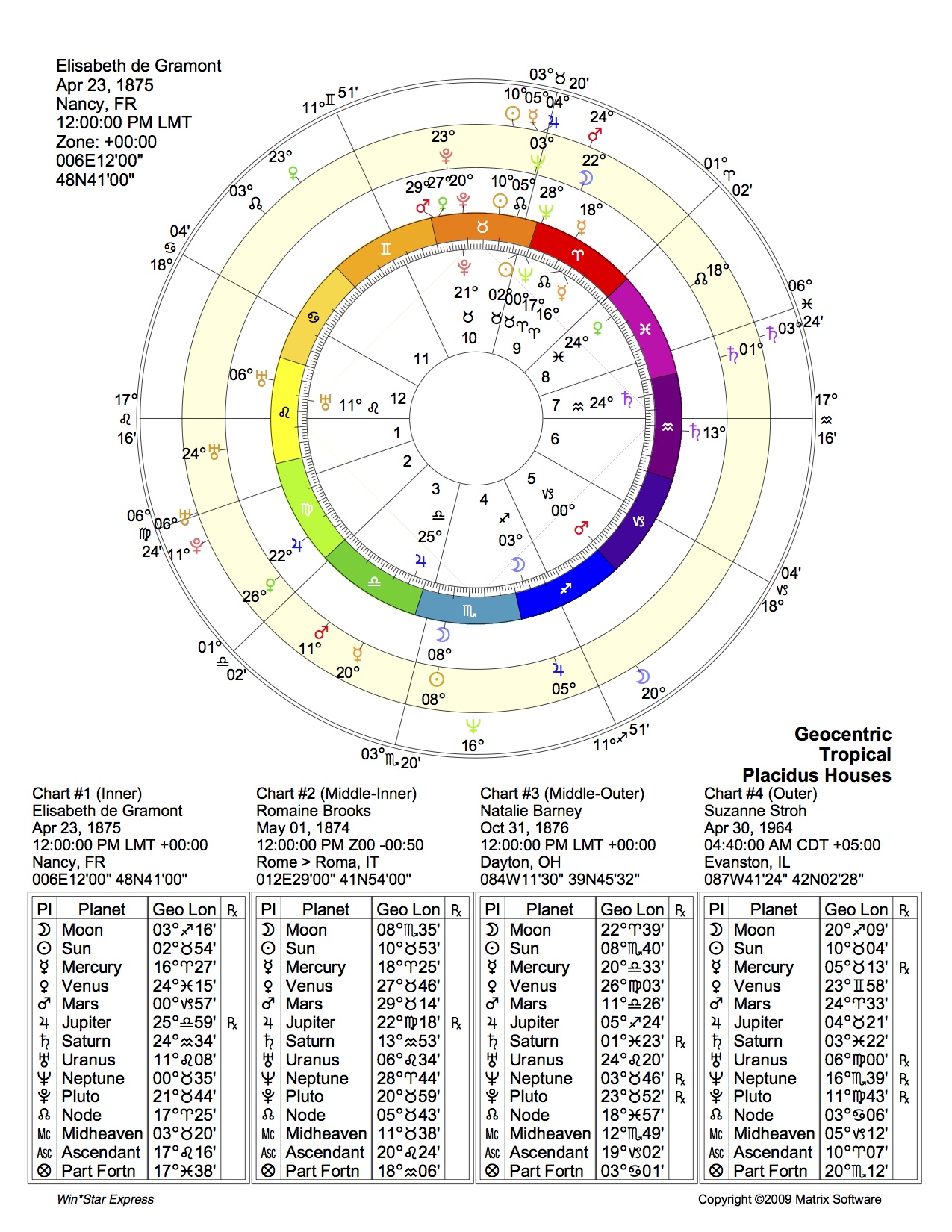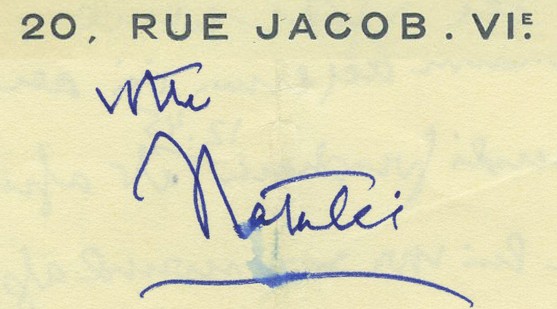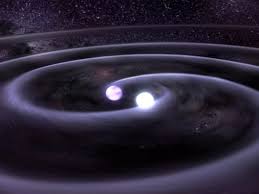30 April 2014

Mapping the Barney/Gramont/Brooks household with Suzanne Stroh on the outside. Three women, Gramont, Barney and Stroh, were/are first born daughters. Charts by A.T. Mann
Binary Star System
Èlisabeth de gramont and natalie Barney
115 years ago today in Paris, two remarkable women were rummaging through their wardrobes looking for something to wear on their first date. Both were in the avant-garde. Radical elites. First-born daughters.
Élisabeth de Gramont, the married mother of two daughters of her own, had just turned 34 the week before. She was a charming, high energy marquise who would one day be a duchess; a music patron who regularly attended science lectures at the Sorbonne and supported the work of Marie Curie; and a leftist intellectual who lived in palaces and consorted with Marxists.
This year she would give the French world its first translations of Keats. Her friends called her Lily.
Lily de Gramont might have rushed home to change after consulting her fortuneteller in the rue de Rome. Like the blonde, athletic woman whose dinner invitation she had accepted last week, gadabout Lily had always been interested in astrology, numerology and the tarot (but for different reasons). The heated debate over whether these ancient pursuits—astrology studies the movement of the stars and planets—were arts or sciences, both or neither, was never resolved in her lifetime. Lily’s sun was in Taurus. Her moon in Scorpio.
A theatrical streak and a night to remember
Thirty-two year-old Natalie Barney had the sun in Scorpio, the moon in Aries and a theatrical streak. “One of her favorite outfits was a long velvet dress emblazoned with astrological signs,” writes her biographer, Suzanne Rodriguez. Natalie was a clever, arty, energetic and culturally voracious American heiress from Cincinnati. She spoke perfect 18th century French after having settled in Paris with her sister around the turn of the century following boarding school at Les Ruches near Barbizon.
Natalie had not yet settled into her new home. It was a Left Bank location, 20 rue Jacob, which would soon become a literary landmark on the map of world capitals. Having Lily de Gramont for supper was one of her first acts as a hostess in this house. Formal, controlled and even cool on the outside, her steamy personal and sexual life was always in disarray. Even her decorating was a bit of a jumble; the small house was lit downstairs like an aquarium capped by a blue bedroom where Natalie hoped to unpetal Lily before the night was through. She would compensate for aesthetic disharmony with good food and excellent wine. Both women were Epicureans with a classical approach to life.
 Lily’s childhood (and best) friend, the French poet Lucie Delarue-Mardrus, had recently introduced them. A few years earlier, as Lily well knew, Lucie had joyously offered Natalie her gay virginity. Natalie had taken it with enthusiasm, along with Lucie’s innocence. Barney was irresistible and passionate about the transformative possibilities of erotic love between women. The problem was, she was openly unfaithful. Nothing would ever transform Natalie Barney into a monogamist. She was “indifferent to everything except the free play of her life,” Lily admitted in her 1931 memoir, Years of Plenty. So Lucie had dumped Natalie in bitterness; now they were slowly rebuilding a friendship that would last for life.
Lily’s childhood (and best) friend, the French poet Lucie Delarue-Mardrus, had recently introduced them. A few years earlier, as Lily well knew, Lucie had joyously offered Natalie her gay virginity. Natalie had taken it with enthusiasm, along with Lucie’s innocence. Barney was irresistible and passionate about the transformative possibilities of erotic love between women. The problem was, she was openly unfaithful. Nothing would ever transform Natalie Barney into a monogamist. She was “indifferent to everything except the free play of her life,” Lily admitted in her 1931 memoir, Years of Plenty. So Lucie had dumped Natalie in bitterness; now they were slowly rebuilding a friendship that would last for life.
What was in store tonight? Lily had never kissed a girl before. Her biographer, Francesco Rapazzini, writes that she had been waiting for the right woman. Was this the one? Natalie had been notorious now for ten years at least, dating back to her affair with the Angelina Jolie of the Belle Époque, courtesan Liane de Pougy, who raked in a small fortune from her tell-all memoir about it. Seeking a more stable fan base, Natalie had since built a Platonic friendship with one of France’s most influential daily columnists, the tastemaker Remy de Gourmont. It was Gourmont who made her famous by giving her the nickname that stuck for a century: l’Amazone.
And then Lily might have found herself ducking into the Amazon’s courtyard off the rue Jacob, taking note of the garden gone to seed and the listing Greek temple hulking off to the side. There she was on the Amazon’s doorstep, tapping her foot at the appointed hour. Natalie would later compare Élisabeth to “a climbing rose with its roots in one garden but who blossoms in another.”
Their letters tell us that two women dined and laughed together, inspirited one another, made heavenly love almost nonstop through the night, and awakened in one another’s arms sometime the next day, having lit an undying flame. Lily believed she had been reborn with a new, sixth sense for pleasure; Natalie suspected she’d always possessed it.
Binary stars, eternal mates
Natalie would test the flame’s durability over the years. She found it to be inextinguishable and necessary for making her life into the work of art she dreamed of. For three decades until Lily’s death in 1954, they would celebrate May 1st as their anniversary. They were never exclusive lovers, and except for a few months after Lily left her husband, they never lived together in the same house. But each had found in the other an “eternal mate.” Natalie described their love as a binary star system in the novel she wrote in 1926 and never published during her lifetime. (Today you can read it in French from ErosOnyx as Amants féminins ou la troisième. And since this post was originally written, it has been published in English as Women Lovers, or The Third Woman.) Imagining the extinction of their flame by the inevitable death of one woman, Natalie wrote of her grief as a cosmological cataclysm: the death of a star.
One hundred fifteen years later, in celebration Lily’s and Natalie’s anniversary on the heels of the tremendously exciting new discoveries in cosmology made in March, I have finally dipped my toe into the “antimatter”—the black hole where astrology might someday meet cosmology. Now, before you roll your eyes, or even shout that “astrology is superstition not science!”, hear me out. I will not contradict you.
My own interest seems to mirror that of many established experts. These are highly numerate people, trained in serious professions from the sciences to engineering and philosophy, who have been wondering all along whether astrology may someday be found to have a scientific grounding. Does Einstein’s theory of relativity—and the acceptance of timespace as a universal concept—indicate that there are quantum effects of gravity? (The new inflation theory discovery seems to be saying there are. Reported and explained fairly well here in Stanford News.) If there are quantum effects of gravity, then why would we not be curious about whether the building materials of very tiny biological organisms here on Earth are affected by it? This is not a crazy question for a humanist or a natural historian, let alone a physicist, a neurologist or a psychiatrist to ask. It’s certainly an age-old question that has been posed, in one way or another, by many cultures seeking deeper understanding of the forces that shape and drive human beings. In fact, it’s safe to say that every woman wonders about this, for instance, whenever she reckons with the moon, along with other unperceivable limbic factors, affecting her menstrual cycle. Physicists have a concept for it as it occurs with all types of vibrations, including tidal waves and waves that exist in tiny materials. They call it resonance.
Putting the predictive or proscriptive aspects of astrology aside, I’ve wondered (along with Lily and Natalie) whether what we consider esoteric factors—factors present at conception—give insight into the forces (resonances?) that brought these two women together on this day 115 years ago.
resonant theories
To learn more and have some fun, I consulted an esteemed expert, astrologer A.T. Mann, an architect-turned-author particularly interested in astrology’s physics-based TOE (theory of everything).
Mann modeled the spiraling movement of our solar system, and thinking in terms of timespace, he uses that model to test whether certain astrological properties describe specific resonances with other times and other places. Traveling “back” on the spiral, you see where the same resonance would also have been “felt” in history. If you’ve ever felt attracted to the arts, letters, math, science, philosophy or culture of certain historical periods, this may begin to explain why. The cells in your body that you’ve inherited in your genome may be resonating the same way they did then and there, based on where you are “today” in the solar system. (And remember, if we wanted to act like good scientists and ask how we would measure that, we’re probably talking about measuring any quantum effects of gravity upon you at the moment of conception. We still don’t have instruments for that yet.) This place, unique to you, closely mirrors places the solar system has been along its spiraling travels before, and will be again. In a weird way, you may really “feel like” people did 300 years ago, 1,000 years ago, or 10,000 years ago, when others (located in a different place on the timespace spiral) just don’t “resonate with that.” Change is accelerating in human history, so some resonances, when located “nearby” in antiquity and modern history, may be very distinctive. You may be into Renaissance or Medieval or Greco-Roman culture, for instance, when other people just can’t see what you see in it. Resonance may be part of the reason why.
Have you ever met somebody and felt you knew them instantly, fully, totally? Whatever may be found to cause that feeling, this is the kind of resonance, or gut reaction, that may be the basis of what some people call the “law of attraction.” Lily and Natalie often told friends that this is what happened to them when they met at Lucie’s house. Natalie’s friend and biographer Jean Chalon reports Natalie’s account of it in detail in Portrait of a Seductress.
What attracts us and attaches us may heal us, even in an impermanent world, as so beautifully expressed in A General Theory of Love by Thomas Lewis, Fari Amini and Richard Lannon, three doctors exploring the physiology of love in humans. Using different tools to investigate how this works on an every-day level, A.T. Mann’s astrology system has some similarities with the Jungian-inspired system called “Spiritual Tarot” practiced by author and Jungian scholar Geraldine Amaral. They both acknowledge what Mann calls “deeply embedded historical archetypes” that cause resonance when we encounter people who look or sound or act like these archetypes.
What interests A.T. Mann is the durability of this particular affinity. Lily and Natalie never wanted to separate from the moment they met. Had they “met before”? Maybe. Their deepest resonance, based on astrological data, goes way, way back and puts them together in an era before recorded history when hominids coexisted on earth, when scientists believe matriarchy characterized cultures and there was no concept of monogamy.
“Well that sounds about right,” I laughed. Mann laughed with me. Then he offered more food for my imagination. According to his system, he can imagine that both women (Gramont and Barney) shared a resonance with other time periods in specific locations, such Italy in the 1500s. “The core of my astrology system,” Mann told me, “is what the Tibetan Buddhists call ‘dependent origination,’ (the term is pratītyasamutpāda) which means that we never start from nothing, but rather our existence itself is dependent upon earlier conditions over which we have little or no control, and which affect us profoundly throughout our lives. Hence my exploration of these incarnational phenomena, of which yours is a very beautiful and poetic example.”
“Meet me in 1909”
Beautiful and poetic? I’ll take it. I was born today, April 30th. Mann modeled my astrological data and compared it with Lily’s and Natalie’s spirals. Where did it put me? Back with the hominid matriarchs, of course! And that’s not all. Our paths “crossed” again more recently, which may explain a lot about my interest in the Moderns. “Gramont, Barney and you all have Saturn in early Pisces or late Aquarius,” writes Mann, “which is the time from the 1890s to just after 1910.”
Like biographer, like subject? “When we connect to people in history,” Mann writes, “it’s because we’re directed to those people by something inside of us.”
Who knows what to make of it all? But it sure is fun guessing today, on my 50th birthday, as I raise a glass and resonate with their beautiful binary star system, still shining bright on their 115th anniversary.


Happy birthday to the imaginative woman who makes this blog sing with creativity. Something Romaine Brooks would have applauded whole-heartedly. Thank you Suzanne for a wonderful and provocative post. As creatives we need to let our imaginations soar taking us to the stars. Both Natalie and Lily seem to recognize this as one of the primary truths. Doubtless,as one of this trio, Romaine Brooks too appreciated this truth. Certainly, she had experience experiences outside the current realm of reality.
As always, so supportive. Thank you. And now for…tomorrow!
Beautiful piece. Cheers to Natalie, Lily and you!
Hello, binary star of mine. Lovely to see you here! And thank you.
Fabulous article and inspiring writing.
Thank you Tad.
Congratulations. What a wonderful piece bringing together what we feel as our instinctual reaction to the stimuli around us. I look forward to toasting your continued success in the years to come.
Jean-Loup, Mann is a fascinating guy. Let’s talk further about this.
What an interesting piece; the interconnection of our universe is not only unending but ever increasing on so many planes that all knowledge in related in so many ways that the Einsteinian coagulation of space-time now seems simple, unarguable and elemental to our understanding of self- in the cosmos. All that is, is simple in that its complexity allows for further understanding of the connections which are true wisdom. Our cosmic understanding is our journey as human beings and we have just begun to understand ourselves as part of nature, universe and cosmos. From the atomic to the cosmic is but a step and we are beginning to chart that path. I am ready for your magnum opus “The Joy of Thinking” and want an autographed copy reserved: Happy Birthday!!!
Jim
Thanks, Jim! Minds wide open! I learn that from you.
[…] I’ve been able to piece together with the help of Langer and Rapazzini. She was in danger. Lily de Gramont knew it and had written to Natalie from Hornfleur, begging her to bring money and bring Romaine […]
[…] to marriage, as the translator of Elisabeth de Gramont, who was first a chattel bride, then a battered wife, then a bigamist with an Eternal Mate, then a […]
http://www.creditsenligne.org/credit-10000-euros/credit-8000-euros – emprunter 1000 euros, сredit 4000 euros.
relevant site http://xnxx-films.com